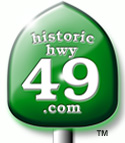                  
|
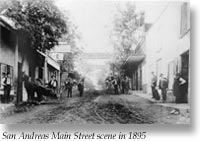
Early
Calaveras
History
Calaveras
County, one of the original 27 counties of the
State, was organized at the 1849-50 session of the
California State Legislature. At one time it
embraced a portion of Amador, Alpine and Mono
Counties. In 1854, Amador County was created from
Calaveras and El Dorado counties, and parts of
Calaveras County was taken to form Fresno County in
1856, Mono County in 1861 and Alpine County in
1864.
Calaveras is a Spanish word
meaning skull. This name was first given to the
river because of the great quantities of human
skulls found along the lower reaches of the
river.
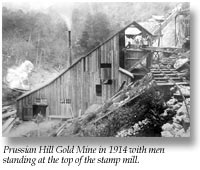 The
first officers of the county were: William Fowle
Smith, County Judge; Colonel Collier, County Clerk;
A. B. Mudge, Treasurer; H. A. Carter, Prosecuting
Attorney. Pleasant Valley, better known as Double
Springs, was designated as the first county seat.
Court was first held in a large tent, and later a
small court house was erected from camphor wood
imported from China. The old building is still
standing at Double Springs. The county seat was
moved to Jackson in 1850 where it remained until
1852. (Jackson was at that time in Calaveras
County.) In 1852 the county seat of Calaveras
county was moved to Mokelumne Hill where it
remained until 1863. After an election in 1863 San
Andreas was declared to be the county seat. Legal
action followed this election, and it was not until
1866 that the county seat was actually moved to San
Andreas where it has since remained. The
first officers of the county were: William Fowle
Smith, County Judge; Colonel Collier, County Clerk;
A. B. Mudge, Treasurer; H. A. Carter, Prosecuting
Attorney. Pleasant Valley, better known as Double
Springs, was designated as the first county seat.
Court was first held in a large tent, and later a
small court house was erected from camphor wood
imported from China. The old building is still
standing at Double Springs. The county seat was
moved to Jackson in 1850 where it remained until
1852. (Jackson was at that time in Calaveras
County.) In 1852 the county seat of Calaveras
county was moved to Mokelumne Hill where it
remained until 1863. After an election in 1863 San
Andreas was declared to be the county seat. Legal
action followed this election, and it was not until
1866 that the county seat was actually moved to San
Andreas where it has since remained.
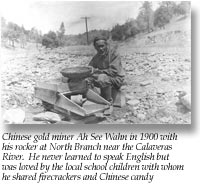 The
Calaveras Chronicle, the first weekly newspaper
published in California, was first published on
October 28, 1851, at Mokelumne Hill. The
Calaveras Chronicle, the first weekly newspaper
published in California, was first published on
October 28, 1851, at Mokelumne Hill.
The first grove of Big Trees,
"Sequoia Gigantea," discovered in California was
the Calaveras Grove of Big Trees. These were
located in 1852 by A. T. Dowd, a hunter for the
Union Water Company which was at that time building
an aqueduct from the Stanislaus River to
Murphys.
The largest gold nugget found
in the United States was taken from the Morgan Mine
at Carson Hill in November, 1854. When weighed on
Adams Express Company's gold scales in Stockton, it
balanced the scales at 214 pounds and eight ounces,
Troy.
The first three story
building erected in the interior of California was
in Mokelumne Hill.
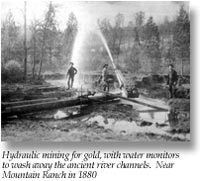 Calaveras
County is famous for its lode and placer mines, and
for many years it was the principal copper
producing county in California. Cement production
from its vast limestone deposits has become one of
the county's major industries in recent
years. Calaveras
County is famous for its lode and placer mines, and
for many years it was the principal copper
producing county in California. Cement production
from its vast limestone deposits has become one of
the county's major industries in recent
years.
The following places were
early day mining communities: Angels Camp, Fourth
Crossing, Mokelumne Hill, Calaveritas, Old Gulch,
Douglas Flat, Vallecito, Murphys, Sheep Ranch, San
Antone, Rich Gulch, Campo Seco, Copperopolis, West
Point, Glencoe, Middle Bar, Carson Hill, Robinson's
Ferry, Jesus Maria, Mountain Ranch, El Dorado,
North Branch, Camanche, Railroad Flat, Blue
Mountain City, Telegraph City, Petersburg, Gwin
Mine and Jenny Lind.
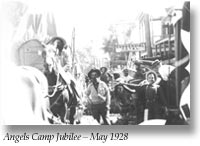 John
W. Robinson and Stephen Mead were licensed by the
Court of Sessions of Calaveras county on August 13,
1850 to maintain a ferry on the Stanislaus River at
Robinson's Ferry. L. Martin and Aristede L. Pench
were licensed to maintain a ferry at Middle Bar on
the Mokelume River on June 5, 1850 by the Court of
Sessions of Calaveras County. John
W. Robinson and Stephen Mead were licensed by the
Court of Sessions of Calaveras county on August 13,
1850 to maintain a ferry on the Stanislaus River at
Robinson's Ferry. L. Martin and Aristede L. Pench
were licensed to maintain a ferry at Middle Bar on
the Mokelume River on June 5, 1850 by the Court of
Sessions of Calaveras County.
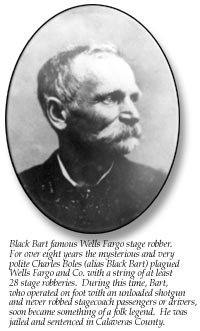
The
Calaveras County
Historical Society
The Calaveras County
Historical Society has one of the best photo
collections in the Mother Lode. These photos are
available to the public for research and limited
private use. We only require a photo credit. Feel
free to come by the office to browse through our
collection.
At the Historical
Society we would gladly help you with research from
our materials. We specialize in pioneer families,
towns, schools, and mining. There is no charge for
the use of our materials, however we do ask for a
donation.
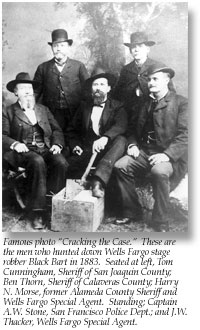
The Historical society also
manages the County Museum located in San Andreas on
Main Street. The museum complex includes the
historic County Courthouse, Hall of Records, and
jail. The notorious Wells Fargo stage robber Black
Bart was held in this jail and sentenced in our
courtroom. Our museum displays also include
artifacts pertaining to Native Americans, local
pioneers, gold mining, minerals, and the Chinese.
We always appreciate donations of local County
artifacts and photos. The museum is open daily from
10-4. We also offer scheduled guided tours for
groups and schools.
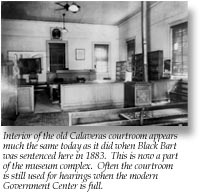
The Museum complex also
includes a Bookstore and Gift Shop. Our Bookstore
specializes in local history. We also have a wide
selection of Gold Rush history books. Our gift
selection includes maps, CD's, tapes, playing
cards, post cards, magnets, T-shirts, shot glasses
and much more. We have videos on Logging,
Railroading, and the Gold Rush. Please stop by when
touring the Mother Lode.
Historichwy49.com
wishes to thank Elizabeth Braydis, Cate Culver and
the Calaveras County Historical Society for their
help and acknowledges the tremendous
accomplishments in creating and maintaining one of
the finest museums in the Gold Country... You do
not want to miss the County Museum located in San
Andreas on Main Street. Photos on this page
courtesy of the Calaveras County Historical
Society.
|



 The
first officers of the county were: William Fowle
Smith, County Judge; Colonel Collier, County Clerk;
A. B. Mudge, Treasurer; H. A. Carter, Prosecuting
Attorney. Pleasant Valley, better known as Double
Springs, was designated as the first county seat.
Court was first held in a large tent, and later a
small court house was erected from camphor wood
imported from China. The old building is still
standing at Double Springs. The county seat was
moved to Jackson in 1850 where it remained until
1852. (Jackson was at that time in Calaveras
County.) In 1852 the county seat of Calaveras
county was moved to Mokelumne Hill where it
remained until 1863. After an election in 1863 San
Andreas was declared to be the county seat. Legal
action followed this election, and it was not until
1866 that the county seat was actually moved to San
Andreas where it has since remained.
The
first officers of the county were: William Fowle
Smith, County Judge; Colonel Collier, County Clerk;
A. B. Mudge, Treasurer; H. A. Carter, Prosecuting
Attorney. Pleasant Valley, better known as Double
Springs, was designated as the first county seat.
Court was first held in a large tent, and later a
small court house was erected from camphor wood
imported from China. The old building is still
standing at Double Springs. The county seat was
moved to Jackson in 1850 where it remained until
1852. (Jackson was at that time in Calaveras
County.) In 1852 the county seat of Calaveras
county was moved to Mokelumne Hill where it
remained until 1863. After an election in 1863 San
Andreas was declared to be the county seat. Legal
action followed this election, and it was not until
1866 that the county seat was actually moved to San
Andreas where it has since remained. The
Calaveras Chronicle, the first weekly newspaper
published in California, was first published on
October 28, 1851, at Mokelumne Hill.
The
Calaveras Chronicle, the first weekly newspaper
published in California, was first published on
October 28, 1851, at Mokelumne Hill. Calaveras
County is famous for its lode and placer mines, and
for many years it was the principal copper
producing county in California. Cement production
from its vast limestone deposits has become one of
the county's major industries in recent
years.
Calaveras
County is famous for its lode and placer mines, and
for many years it was the principal copper
producing county in California. Cement production
from its vast limestone deposits has become one of
the county's major industries in recent
years. John
W. Robinson and Stephen Mead were licensed by the
Court of Sessions of Calaveras county on August 13,
1850 to maintain a ferry on the Stanislaus River at
Robinson's Ferry. L. Martin and Aristede L. Pench
were licensed to maintain a ferry at Middle Bar on
the Mokelume River on June 5, 1850 by the Court of
Sessions of Calaveras County.
John
W. Robinson and Stephen Mead were licensed by the
Court of Sessions of Calaveras county on August 13,
1850 to maintain a ferry on the Stanislaus River at
Robinson's Ferry. L. Martin and Aristede L. Pench
were licensed to maintain a ferry at Middle Bar on
the Mokelume River on June 5, 1850 by the Court of
Sessions of Calaveras County.

